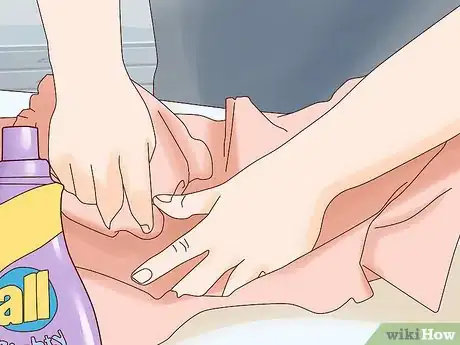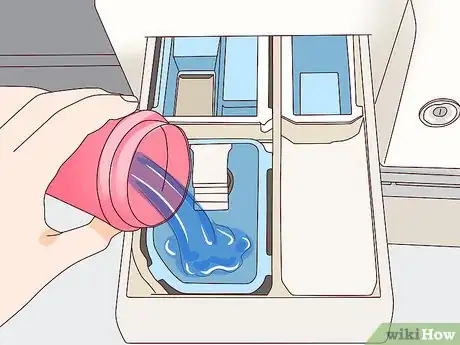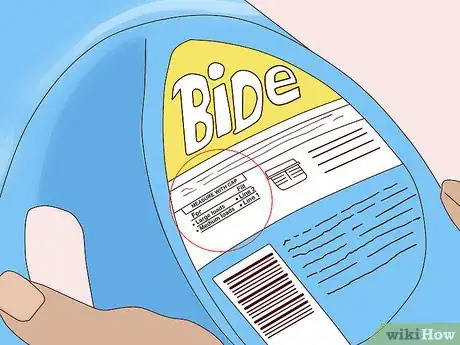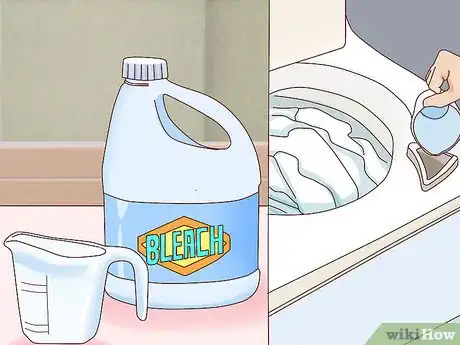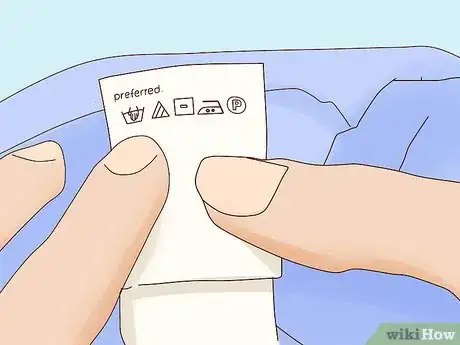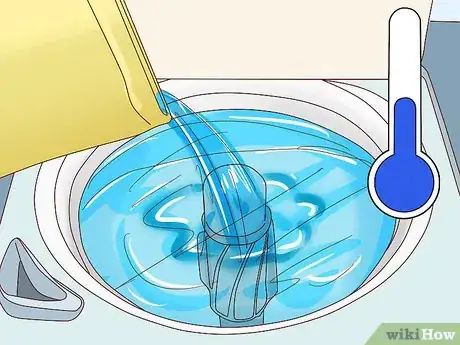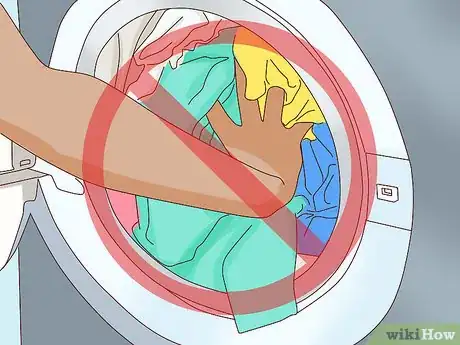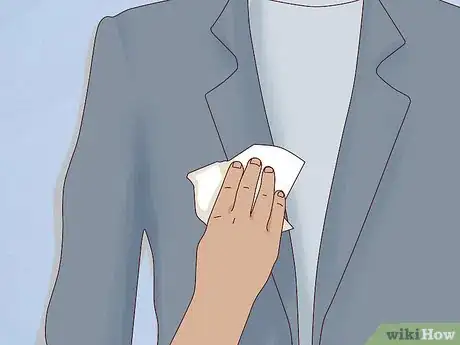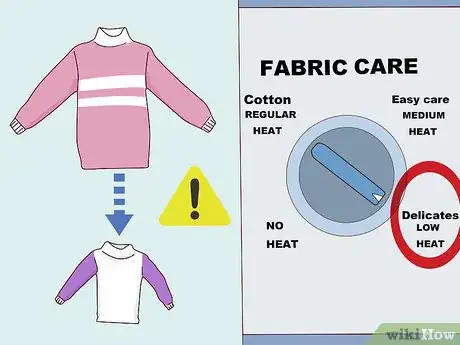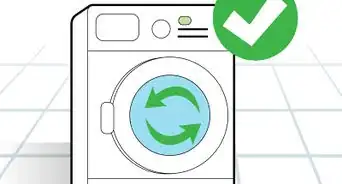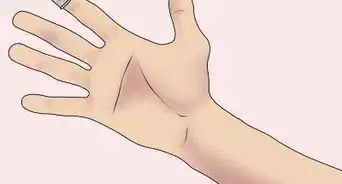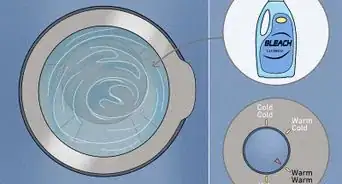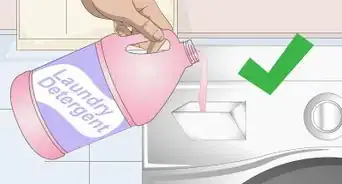This article was co-authored by Safir Ali. Safir Ali is the Co-Founder and CEO of Hamper Dry Cleaning and Laundry, a startup in Houston, Texas reinventing the laundry industry. With over six years of experience launching and operating Hamper, Safir specializes in innovative ways to simplify dry cleaning using the experience from his family's business. Safir holds a Bachelor’s degree in Business Administration and Management from Texas A&M University. Hamper offers 24/7 on-demand dry cleaning and laundry through delivery and kiosk services. Hamper has been featured on the Houston Rockets, Station Houston, the Houston Business Journal, BBVA, Yahoo Finance, and Innovation Map.
wikiHow marks an article as reader-approved once it receives enough positive feedback. In this case, 97% of readers who voted found the article helpful, earning it our reader-approved status.
This article has been viewed 1,054,795 times.
Doing laundry is a chore that every independent person has to do at some point. Fortunately, it doesn't have to be difficult or extremely time-consuming. You'll want to prepare by gathering supplies and sorting your laundry, treat stains and add the right detergent, and choose the correct wash cycle and temperature for your load. Finally, you'll need to dry your laundry according to the fabric type of each item in your load.
Steps
How to Sort Your Laundry
-
1Keep your dirty laundry in hampers according to your preference. Buy hampers or baskets to keep piles separated as you use your items, or use one main hamper and separate your laundry right before you wash it. How you choose to store your unwashed laundry will likely depend on how much space you have and if you have to leave your home in order to do your laundry.[1]
- Hampers come in various styles. Some have wheels or handles to make transportation easier; consider one of these if you will be moving yours around.
- Hampers are also made from different materials. Choose a cloth one that folds up to save on storage space. Plastic ones often have handles that make them easy to carry; while wicker ones are often kept stationary and are more decorative.
-
2Create piles of similar fabrics. It's wise to separate your fabrics into heavy fabrics and lightweight or thin fabrics. This way, you can choose the wash cycle that is appropriate for the type of fabric of your load.[2]
- For example, create a heavy fabric pile that includes your jeans, heavy cotton sweatshirts or pants, jackets, and heavy workout clothing.
- Create a different pile for lighter T-shirts, blouses, and thin pants.
- Maintain a separate pile for delicates like lingerie, pantyhose, and silks, and other piles for towels and bed linens.
Advertisement -
3Separate your clothes into whites, lights, and darks. In addition to separating your laundry by fabric, you should also separate it by color to avoid having dark colors bleed onto whites or lighter colors. Create a whites pile that includes your white T-shirts, socks, underwear, and any other sturdy white clothing items.[3]
- Create a separate pile of lights, which includes pastels like light blues and greens, yellows, and pinks.
- Keep a separate pile of your dark clothing: anything black, grey, navy blue, red, or dark purple would go into this pile.
How to Treat Stains and Add Detergent
-
1Buy detergent designed for your type of washer. Some detergents are designed for traditional top-loading washers, some are for high-efficiency or front-loading washers, and some can be used for both. Find out which type of machine you have and buy detergent that you like for your model.[4]
- If you have sensitive skin or are prone to allergies, buy detergent that is labeled natural, fragrance-free, or free and clear.
-
2Treat stains with stain remover or detergent immediately. You'll have the most success removing a stain if you treat it as soon as it occurs. As soon as you're able to, apply a stain remover or some liquid detergent to the stain and gently rub it in.[5] Allow the product to remain on the stain for at least 5 minutes before washing the item.[6]
- You can also treat stains by allowing them to soak in cold water for 30 minutes before washing them. Use a large container, sink, or the soak setting on your machine to do this.
-
3Add detergent to the sliding drawer on a front-loading machine. High-efficiency and front-loading machines will most likely have a small sliding drawer where you add detergent any time before starting the cycle, and the machine will automatically dispense the detergent as the cycle progresses.[7]
- Read the instruction booklet of your machine if you cannot locate the sliding drawer for detergent on your machine.
-
4Add detergent to the tub of a top-loading machine. Top-loading washers may require you to fill the tub with water first, add the detergent into the tub, then add your laundry last. Read the instructions inside the lid of your machine to see exactly how to add your detergent.[8]
-
5Add the right amount of detergent according to package instructions. Read your detergent instructions to see how much detergent to add. Different detergents will require you to add different amounts, and it's important to follow the instructions exactly to avoid adding too much detergent.[9]
- Adding too much detergent can cause a soapy residue to remain on your clothes after they are rinsed.
-
6Add bleach to your whites to keep them bright. Locate the section in your washer for adding bleach. It should be near the area where you add detergent in a front-loading washer, and on one of the sides at the top of the tub of a top-loading washer.[10] Read the instructions on your bleach to see how much to add for the amount of laundry that you are washing.[11]
- Some non-chlorinated bleaches are marked color-safe, therefore you can use them with colors that could use some extra brightening.
-
7Use liquid fabric softener if you'd like extra soft clothes. If your clothes sometimes come out of the laundry stiff and rough, consider using liquid fabric softener with your load. This is especially helpful if the water you use if hard and chemically treated.[12]
How to Choose Your Wash Cycle and Temperature
-
1Read the care tags on your clothing. You may have some items that require certain cycle or temperature requirements; it's always wise to read the tag if you're washing something for the first time or can't remember what its tag says.[13]
-
2Use the normal setting for sturdy fabrics. The normal or regular setting on a washer usually means both the wash and rinse cycles spin fast. These settings are ideal for fabrics that are sturdy, like jeans, sweatshirts, and towels.[14]
- The normal or regular settings also work well for clothes that are very dirty; just be careful that they are not delicate items with fine fabric or embellishments.
- Some washers also have a heavy-duty setting; use this only for sturdy fabrics that are very dirty.
-
3Choose the permanent press setting for clothes that are prone to wrinkling. Some fabrics in blouses and pants, like linen and rayon, become wrinkled easily. Choose the permanent press setting on your washer, which will have a slower spin cycle at the end, to help these items stay wrinkle-free when you wash them.[15]
-
4Pick the delicate cycle for fine fabrics or embellishments. The delicate cycle on your washer means the cycle will spin slowly for both wash and rinse, and is designed for fine fabrics like lingerie, pantyhose, or items that have beads, sequins, embroidery, or other delicate embellishments.[16]
- Certain fabrics like many silks and woolen items, should not be placed in a washer at all and should be hand-washed or dry-cleaned. Be sure to read the tags on your laundry items before placing them in the washing machine.
-
5Use cold water most of the time. Most detergents are actually now designed to work best using cold water. In addition, most fabrics last longer if they are not exposed to heat. You can save money and energy by washing your clothes in cold water as opposed to warm or hot.[17]
- Shrinkable fabrics like cotton should always be washed in cold water and should be dried on a low-heat setting.[18]
- Some people become concerned that germs will not be killed in cold water. However, your detergent does work on eliminating germs, as does the heat from the dryer if you dry your laundry on any heat setting, even low-heat.
-
6Choose hot water only for very dirty laundry. If you're washing pillowcases and sheets used by a sick person, or muddy outdoor clothes or uniforms, use hot water if you wish. Hot water will fade colors over time, so you're better off not using it more often than absolutely necessary.[19]
- Avoid using hot water on stained clothes or brand new colored clothing. Hot water can cause stains to set and colors to bleed.
-
7Don't overfill the machine when you add your load. Most machines have instructions on filling or a fill-line right on the machine that you are not to exceed when putting items inside. Be sure not to cram more laundry in the machine than is recommended for your model.[20]
- Overfilling your machine can cause your laundry to not clean properly, and over time, it can cause your machine to break.
How to Dry Your Laundry
-
1Remove lint from the lint trap before drying each load. Find the lint trap on your dryer and check it for lint every time you use your dryer before turning it on. Slide the trap out of its position, and run your fingers over the lint to gather it up, then throw the lint in a trash can.[21]
- Not removing lint before using a dryer can cause your dryer to catch on fire.
-
2Use dryer sheets for softer, static-free clothes. Dryer sheets can help reduce static on clothes and can make them softer after a wash. Choose sheets that have a scent that you like, or fragrance-free ones if you have chemical sensitivities.[22]
-
3Choose a regular setting for jeans, sweatshirts, and towels. Sturdier fabrics can withstand the heat and fast tumble of a regular dryer setting. In addition, the thicker materials may not become fully dry on lower settings.[23]
- If you are concerned about certain items shrinking or fading, use a lower heat setting or air-dry the item.
-
4Use permanent press for most of your clothes and sheets. Permanent press uses medium heat but has a slower spin toward the end to reduce wrinkles that commonly happen on items when they are dried in the dryer. Choose this setting to get your clothes and sheets fully dry without getting them wrinkled.[24]
- Some dryers may call this setting by other names such as wrinkle-free, wrinkle-resistant, or fast/slow.
-
5Dry shrink-prone materials on delicate or tumble-dry. The delicate setting uses low heat and a slower spin, and is ideal for items that may shrink or that could be easily damaged. Tumble-dry doesn't use any heat and should be used for items that are extremely delicate or likely to shrink.[25]
-
6Air-dry items to make them last longer. You can hang any item up on a line to dry if you want to lengthen its life-span.[26] Simply buy some clothespins or hangers to hang your items outside or inside.[27]
- Alternatively, you can dry items by laying them flat on a towel, or using a drying rack. This helps reduce dry-lines or bumps that can occur on the shoulders of shirts when they are hung to dry.
-
7Iron your laundry as needed and put it away. If you have items that become wrinkled in your laundry, use an iron and ironing board to remove the wrinkles. Be sure to read the care tag on your wrinkled item to see which heat setting to use, and set your iron to the correct temperature accordingly.
- Put your laundry according to your preference when you are finished doing your laundry. Either fold it up and put it in drawers, or hang it in a closet, depending on the space you have at home.
Community Q&A
-
QuestionHow do you do laundry in the bathtub?
 wikiHow Staff EditorThis answer was written by one of our trained team of researchers who validated it for accuracy and comprehensiveness.
wikiHow Staff EditorThis answer was written by one of our trained team of researchers who validated it for accuracy and comprehensiveness.
Staff Answer wikiHow Staff EditorStaff AnswerCheck the labels on the clothing to find out what temperature of water is best. If you want to use hot water, make sure it’s not hot enough to scald your hands. Plug and fill the tub, pour in a little gentle detergent that’s made for hand washing, then put in the item(s) you’d like to wash. Swish them around with your hands in the water and gently squeeze them to work the soap and water through the fibers. Drain the tub and rinse the clothes with fresh water, then wring or squeeze out as much water as possible. Lay the clothes flat or put them on a line to dry.
wikiHow Staff EditorStaff AnswerCheck the labels on the clothing to find out what temperature of water is best. If you want to use hot water, make sure it’s not hot enough to scald your hands. Plug and fill the tub, pour in a little gentle detergent that’s made for hand washing, then put in the item(s) you’d like to wash. Swish them around with your hands in the water and gently squeeze them to work the soap and water through the fibers. Drain the tub and rinse the clothes with fresh water, then wring or squeeze out as much water as possible. Lay the clothes flat or put them on a line to dry. -
QuestionHow do you safely wash the laundry of a person infected with COVID-19?
 wikiHow Staff EditorThis answer was written by one of our trained team of researchers who validated it for accuracy and comprehensiveness.
wikiHow Staff EditorThis answer was written by one of our trained team of researchers who validated it for accuracy and comprehensiveness.
Staff Answer wikiHow Staff EditorStaff AnswerWear gloves and a mask while you handle the person’s laundry, and handle the clothes carefully so you don’t shake virus fragments into the air. Line the hamper or basket with a removable liner that you can wash or throw away between loads of laundry. Wash and dry the clothes on the hottest settings you can use without damaging them.
wikiHow Staff EditorStaff AnswerWear gloves and a mask while you handle the person’s laundry, and handle the clothes carefully so you don’t shake virus fragments into the air. Line the hamper or basket with a removable liner that you can wash or throw away between loads of laundry. Wash and dry the clothes on the hottest settings you can use without damaging them. -
QuestionHow do you do laundry in college?
 wikiHow Staff EditorThis answer was written by one of our trained team of researchers who validated it for accuracy and comprehensiveness.
wikiHow Staff EditorThis answer was written by one of our trained team of researchers who validated it for accuracy and comprehensiveness.
Staff Answer wikiHow Staff EditorStaff AnswerIf you live in a dorm or other student housing, there’s a good chance you’ll have access to a shared laundry room. To operate the machines, you’ll need either quarters or a laundry card that you can reload with cash. Bring your own supplies, such as a laundry basket, detergent, and dryer sheets (which reduce static and give your clothes a nice smell). Since the laundry room is shared, keep track of when your clothes are done so they don’t sit in the washer or dryer and prevent other students from using them!
wikiHow Staff EditorStaff AnswerIf you live in a dorm or other student housing, there’s a good chance you’ll have access to a shared laundry room. To operate the machines, you’ll need either quarters or a laundry card that you can reload with cash. Bring your own supplies, such as a laundry basket, detergent, and dryer sheets (which reduce static and give your clothes a nice smell). Since the laundry room is shared, keep track of when your clothes are done so they don’t sit in the washer or dryer and prevent other students from using them!
Things You'll Need
- Hampers or baskets
- Laundry detergent
- Washer and dryer
- Clothespins or hangers (optional)
References
- ↑ https://www.universitylanguage.com/blog/31/college-laundry/
- ↑ https://www.mamaslaundrytalk.com/laundry-basics-how-to-sort-clothes/
- ↑ https://www.mamaslaundrytalk.com/laundry-basics-how-to-sort-clothes/
- ↑ https://www.consumerreports.org/washing-machines/how-to-do-laundry-without-ruining-your-clothes/
- ↑ Safir Ali. Professional Dry Cleaner. Expert Interview. 15 September 2020.
- ↑ https://www.consumerreports.org/washing-machines/how-to-do-laundry-without-ruining-your-clothes/
- ↑ https://www.consumerreports.org/washing-machines/how-to-do-laundry-without-ruining-your-clothes/
- ↑ https://www.consumerreports.org/washing-machines/how-to-do-laundry-without-ruining-your-clothes/
- ↑ https://www.consumerreports.org/washing-machines/how-to-do-laundry-without-ruining-your-clothes/
- ↑ Safir Ali. Professional Dry Cleaner. Expert Interview. 15 September 2020.
- ↑ https://www.consumerreports.org/washing-machines/how-to-do-laundry-without-ruining-your-clothes/
- ↑ https://www.consumerreports.org/washing-machines/how-to-do-laundry-without-ruining-your-clothes/
- ↑ https://www.nytimes.com/guides/smarterliving/how-to-do-laundry
- ↑ https://www.nytimes.com/guides/smarterliving/how-to-do-laundry
- ↑ https://www.nytimes.com/guides/smarterliving/how-to-do-laundry
- ↑ https://www.nytimes.com/guides/smarterliving/how-to-do-laundry
- ↑ https://www.consumerreports.org/washing-machines/how-to-do-laundry-without-ruining-your-clothes/
- ↑ Safir Ali. Professional Dry Cleaner. Expert Interview. 15 September 2020.
- ↑ https://www.nytimes.com/guides/smarterliving/how-to-do-laundry
- ↑ https://www.consumerreports.org/washing-machines/how-to-do-laundry-without-ruining-your-clothes/
- ↑ https://www.nytimes.com/guides/smarterliving/how-to-do-laundry
- ↑ https://www.nytimes.com/guides/smarterliving/how-to-do-laundry
- ↑ https://www.nytimes.com/guides/smarterliving/how-to-do-laundry
- ↑ https://www.nytimes.com/guides/smarterliving/how-to-do-laundry
- ↑ https://www.nytimes.com/guides/smarterliving/how-to-do-laundry
- ↑ Safir Ali. Professional Dry Cleaner. Expert Interview. 15 September 2020.
- ↑ https://www.nytimes.com/guides/smarterliving/how-to-do-laundry
About This Article
If you need to do laundry, separate your clothing according to the type of fabric, then by color. Once you’ve gathered enough clothes to wash, place them in the washing machine along with the detergent. Select the appropriate load for the fabric type, such as a gentle wash for delicate fabrics or a hot water cycle for very dirty clothes. When the clothes are finished washing, move them to the dryer and choose the lowest heat setting possible. Clean the lint trap in your dryer before you turn it on, and add a dryer sheet to make your clothes softer and static-free. For tips on air-drying your clothes, keep reading!




